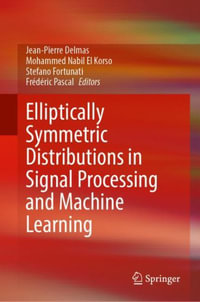
At a Glance
480 Pages
24.13 x 16.0 x 2.79
Hardcover
RRP $387.15
$319.75
17%OFF
or 4 interest-free payments of $79.94 with
orAims to ship in 7 to 10 business days
Industry Reviews
1. Brief review of Electromagnetics and Guided Waves.
1.1 Introduction.
1.2 Maxwell's equations.
1.3 Uniform plane waves in isotropic media.
1.4 State of polarization.
1.5 Reflection and refraction by a planar boundary between two dielectric media.
1.5.1. Perpendicular polarization.
1.5.1.1 Reflection and refraction.
1.5.1.2 Total internal reflection.
1.5.2. Parallel polarization.
1.5.2.1 Reflection and refraction.
1.5.2.2 Total internal reflection.
1.6 Guided waves.
1.6.1 TE modes.
1.6.2 TM modes.
1.6.3 Waveguides with constant index regions.
References.
Problems.
List of Figures.
2. Step-index Thin-film Waveguides.
2.1 Introduction.
2.2 Dispersion of step-index thin-film waveguides.
2.2.1 TE modes.
2.2.2 TM modes.
2.3 Generalized parameters.
2.3.1 a, b, c, d and V.
2.3.2 bV diagram.
2.3.3 Cutoff thickness and cutoff frequencies.
2.3.4 Number of guided modes.
2.3.5 Birefringence in thin-film waveguides.
2.4 Fields of step-index thin-film waveguides.
2.4.1 TE modes.
2.4.2 TM modes.
2.5 Cover and substrate modes.
2.6 Time-average power and confinement factors.
2.6.1 Time-average power transported by TE modes.
2.6.2 Confinement factor of TE modes.
2.6.3 Time-average power transported by TM modes.
2.7 Phase and group velocities.
References.
Problems.
List of figures.
3. Graded-index Thin-film waveguides.
3.1 Introduction.
3.2 TE modes guided by linearly graded dielectric waveguides.
3.3 Exponentially graded dielectric waveguides.
3.3.1 TE modes.
3.3.2 TM modes.
3.4 WKB method.
3.4.1 Auxiliary function.
3.4.2 Fields in the R Zone.
3.4.3 Fields in the L Zone.
3.4.4 Fields in the transition zone.
3.4.5 The constants.
3.4.6 The dispersion relation.
3.4.7 An example.
3.5 Hocker and Burns? numerical method.
3.5.1 TE modes.
3.5.2 TM modes.
3.6 Step-index thin-film waveguides vs. graded-index dielectric waveguides.
References.
Problems.
List of figures.
4. Propagation Loss in Thin-film Waveguides.
4.1 Introduction.
4.2 Complex relative dielectric constant and complex refractive index.
4.3 Propagation loss in step-index waveguides.
4.3.1 Waveguides having weakly absorbing materials.
4.3.2 Metal-clad waveguides.
4.4 Attenuation in thick waveguides with step-index profiles.
4.5 Loss in TM0 mode.
4.6 Metal-clad waveguides with graded index profiles.
References.
Problem.
List of Figures.
5. Three-dimensional Waveguides with Rectangular Boundaries.
5.1 Fields and modes guided by rectangular waveguides.
5.2 Orders of magnitude of fields.
5.2.1 modes.
5.2.2 modes.
5.3 Marcatili's method.
5.3.1 modes.
5.3.1.1 Expressions for Hx.
5.3.1.2 Boundary conditions along horizontal boundaries, y = ±h/2, |x|
5.3.1.5 Transverse wave vector Ky.
5.3.1.6 Approximate dispersion relation.
5.3.2 modes.
5.3.3 Discussions.
5.3.4 Generalized guide index.
5.4 Effective index method.
5.4.1 A pseudo waveguide.
5.4.2 An alternate pseudo waveguide.
5.4.3 Generalized guide index.
5.5 Comparison of methods.
References.
Problems.
List of figures.
6. Optical directional couplers and their applications.
6.1 Introduction.
6.2 Qualitative description of the operation of directional couplers.
6.3 Marcatili?s improved coupled mode equations.
6.3.1 Fields of isolated waveguides.
6.3.2 Normal mode fields of the composite waveguide.
6.3.3 Marcatili?s relation.
6.3.4 Approximate normal mode fields.
6.3.5 Improved coupled mode equations.
6.3.6 Coupled mode equation in an equivalent form.
6.3.7 Coupled mode equation in an alternate form.
6.4 Directional couplers with uniform cross section and constant spacing.
6.4.1 Transfer matrix.
6.4.2 Essential characteristics of couplers with K1 = K2 = K.
6.4.3 3 dB directional couplers.
6.4.4 Directional couplers as electrically controlled optical switches.
6.4.5. Switching diagram.
6.5 Switched ?? directional couplers.
6.6 Optical directional couplers filters.
6.6.1 Directional coupler filters with identical waveguides and uniform spacing.
6.6.2 Directional coupler filters with non-identical waveguides and uniform spacing.
6.6.3 Tapered directional coupler filters.
6.7 Intensity modulators based on directional couplers.
6.7.1 Electrooptic properties of lithium niobate.
6.7.2 Dielectric waveguide with an electrooptic layer.
6.7.3 Directional coupler modulator built on a Z-cut LiNbO3 plate.
6.8 Normal mode theory of directional couplers with two waveguides.
6.9 Normal mode theory of directional couplers with three or more waveguides.
References.
Problems.
List of Figures.
7. Guided-wave Gratings.
7.1 Introduction.
7.1.1 Types of guided-wave gratings.
7.1.1.1 Static gratings.
7.1.1.2 Programmable gratings.
7.1.1.3 Moving grating.
7.1.2 Applications of guided-wave gratings.
7.1.3. Two methods for analyzing guided-wave grating problems.
7.2 Perturbation theory.
7.2.1 Waveguide perturbation.
7.2.2 Fields of perturbed waveguide.
7.2.3 Coupled mode equations and coupling coefficients.
7.2.4 Co-directional coupling.
7.2.5 Contra-directional coupling.
7.3 Coupling coefficient of a rectangular grating-an example.
7.4 Graphical representation of grating equation.
7.5 Grating reflectors.
7.5.1 Coupled mode equations.
7.5.2 Filter response of grating reflectors.
7.5.3 Bandwidth of grating reflectors.
7.6 Distributed feedback lasers.
7.6.1 Coupled mode equations with optical gain.
7.6.2 Boundary conditions and symmetric condition.
7.6.3 Eigen value equations.
7.6.4 Mode patterns.
7.6.5 Oscillation frequency and threshold gain.
References.
List of Figures.
8. Arrayed-waveguide Gratings.
8.1 Introduction.
8.2 Arrays of isotropic radiators.
8.3 Two examples.
8.3.1 Arrayed-waveguide gratings as dispersive components.
8.3.2 Arrayed-waveguide gratings as focusing components.
8.4 1x2 arrayed-waveguide grating multiplexers and demultiplexers.
8.4.1 Waveguide grating elements.
8.4.2 Output waveguides.
8.4.3 Spectral response.
8.5 NxN arrayed-waveguide grating multiplexers and demultiplexers.
8.6 Applications in WDM communications.
References.
List of Figures.
9. Transmission characteristics of step-index optical fibers.
9.1. Introduction.
9.2. Fields and propagation characteristic of modes guided by step-index fibers.
9.2.1 Electromagnetic fields.
9.2.2 Characteristic equation.
9.2.3 Traditional mode designation and fields.
9.3. Linearly polarized modes guided by weakly guiding step-index fibers.
9.3.1 Basic properties of fields of weakly guiding fibers..
9.3.2 Fields and boundary conditions.
9.3.3 Characteristic equation and mode designation.
9.3.4 Fields of x-polarized LP0m modes.
9.3.5 Time-average power.
9.3.6 Single mode operation.
9.4. Phase velocity, group velocity and dispersion of linearly polarized modes.
9.4.1 Phase velocity and group velocity.
9.4.2 Dispersion.
9.4.2.1 Intermodal dispersion.
9.4.2.2 Intramodal dispersion.
9.4.2.3 Zero dispersion wavelengths.
References.
Problems.
List of Figures.
10. Input and output characteristics of weakly guiding step-index fibers.
10.1 Radiation of LP modes.
10.1.1 Radiated fields in the Fraunhofer zone.
10.1.2 Radiation by a Gaussian aperture field.
10.1.3 Experimental determination of ka and V.
10.2 Excitation of LP modes.
10.2.1 Power coupled to LP mode .
10.2.2 Gaussian beam excitation.
References.
Problems.
List of Figures.
11. Birefringence in Single-mode Fibers.
11.1 Introduction.
11.2 Geometrical birefringence.
11.3 Birefringence due to build-in stress.
11.4 Birefringence due to externally applied mechanical stress.
11.4.1 Lateral stress.
11.4.2 Bending.
11.4.2.1 Pure bending.
11.4.2.1 Bending under tension.
11.4.3 Mechanical twisting.
11.5 Birefringence due to externally applied electric and magnetic fields.
11.5.1 Strong transverse electric fields.
11.5.2 Strong axis magnetic fields.
11.6 Jones matrices of birefringent fibers.
11.6.1 Linearly birefringent fibers with stationary birefringent axes.
11.6.2 Linearly birefringent fiber with a continuous rotating axis.
11.6.3 Circularly birefringent fibers.
11.6.4 Linearly and circularly birefringent fibers.
11.6.5 Fibers with linear and circular birefringence and axis rotation.
Problems.
References.
12. Manufactured fibers.
12.1 Introduction.
12.2 Power-law index fibers.
12.3 Key propagation and dispersion parameters of graded index fibers.
12.3.1 Generalized guide index b.
12.3.2 Normalized group delay.
12.3.3 Group delay and the confinement factor.
12.3.4 Normalized waveguide dispersion.
12.3.5 An example.
12.4 Radiation and excitation characteristics of graded index fibers.
12.4.1 Radiation.
12.4.2 Excitation by a linearly polarized Gaussian beam.
12.5 Mode field radius.
12.5.1 Marcuse?s mode field radius.
12.5.2 First Petermann?s mode field radius.
12.5.3 Second Petermann?s mode field radius.
12.5.4 Comparison of three mode field radii.
12.6 Mode field radius and key propagation and dispersion parameters.
References.
Problems.
List of Figures.
13. Propagation of pulses in single-mode fibers.
13.1 Introduction.
13.2 Dispersion and group velocity dispersion.
13.3 Fourier transform method.
13.4 Propagation of Gaussian pulses in fibers.
13.4.1 Effects of? the first order group dispersion.
13.4.2 Effects of the second order group dispersion.
13.5 Impulse response.
13.5.1 Approximate impulse response function with ?" ignored.
13.5.2 Approximate impulse response function with ?" ignored.
13.6 Propagation of rectangular pulses in fibers.
13.7 Envelope equation.
13.7.1 Monochromatic waves.
13.7.2 Envelop equation.
13.7.3 Pulse envelop in non-dispersive media.
13.7.4 Effect of the first order group velocity dispersion.
13.7.5 Effect of the second order group velocity dispersion.
13.8 Dispersion compensation.
References.
Problems.
List of Figures.
14. Optical Solitons in Optical Fibers.
14.1 Introduction.
14.2 Optical Kerr effect in isotropic media.
14.2.1 Electric susceptibility tensor.
14.2.2 Refractive index.
14.3 Nonlinear envelope equation.
14.3.1 Linear and third-order polarizations.
14.3.2 Nonlinear envelope equation for nonlinear media.
14.3.3 Self-phase modulation.
14.3.4 Nonlinear envelope equation for nonlinear fibers.
14.3.5 Nonlinear Schrodinger equation.
14.4 Qualitative description of solitons.
14.5 Fundamental solitons.
14.5.1 Canonical expression.
14.5.2 General expression.
14.5.3 Basic soliton parameters.
14.5.4 Basic soliton properties.
14.6 Higher-order solitons.
14.6.1 Second-order solitons.
14.6.2 Third-order solitons.
14.7 Generation of solitons.
14.7.1 Integer A.
14.7.2 Non-integer A.
14.8 Soliton units of time, distance and power.
14.9 Interaction of solitons.
References.
List of Figures.
Appendix A: Brown Identity.
A.1 Wave equations for inhomogeneous media.
A.2 Brown identity.
A.3 Two special cases.
A.4 Effect of material dispersion.
References.
Appendix B: Two-dimensional Divergence Theorem and Green?s Theorem.
Appendix C. Orthogonality and Orthonormality of Guided Modes.
C.1 Lorentz? reciprocity.
C.2 Orthogonality of guided modes.
C.3 Orthonormality of guided modes.
References.
Appendix D: Elasticity, Photoelasticity and Electrooptic Effects.
D1 Strain tensors.
D1.1 Strain tensors in one-dimensional objects.
D1.2 Strain tensors in two-dimensional objects.
D1.3 Strain tensors in three-dimensional objects.
D2 Stress tensors.
D3 Hook?s law in isotropic materials.
D4 Strain and stress tensors in abbreviated indices.
D5 Relative dielectric constant tensors and relative dielectric impermeability tensors.
D6 Photoelastic effect and photoelastic constant tensors.
D7 Index change in isotropic solids: an example.
D8 Linear electrooptic effects.
D9 Quadratic electrooptic effects.
References.
List of Figures.
Appendix E: Effect of mechanical twisting on fiber birefringence.
E1. Relative dielectric constant tensor of a twisted medium.
E2. LP modes in weakly guiding, untwisted fibers.
E3. Eigen polarization modes in twisted fibers.
References.
Appendix F: Derivation of (12.7), (12.8) and (12.9).
Appendix G: Two Hankel transform relations.
Index.
ISBN: 9780471756873
ISBN-10: 0471756873
Published: 31st October 2006
Format: Hardcover
Language: English
Number of Pages: 480
Audience: Professional and Scholarly
Publisher: John Wiley & Sons Inc (US)
Country of Publication: US
Edition Number: 1
Dimensions (cm): 24.13 x 16.0 x 2.79
Weight (kg): 0.78
Shipping
| Standard Shipping | Express Shipping | |
|---|---|---|
| Metro postcodes: | $9.99 | $14.95 |
| Regional postcodes: | $9.99 | $14.95 |
| Rural postcodes: | $9.99 | $14.95 |
How to return your order
At Booktopia, we offer hassle-free returns in accordance with our returns policy. If you wish to return an item, please get in touch with Booktopia Customer Care.
Additional postage charges may be applicable.
Defective items
If there is a problem with any of the items received for your order then the Booktopia Customer Care team is ready to assist you.
For more info please visit our Help Centre.
You Can Find This Book In

INCOSE Systems Engineering Handbook
5th Edition - A Guide for System Life Cycle Processes and Activities
Paperback
RRP $149.95
$92.50
OFF





















